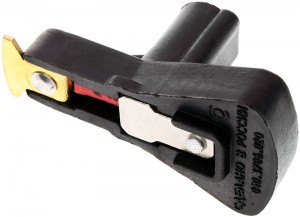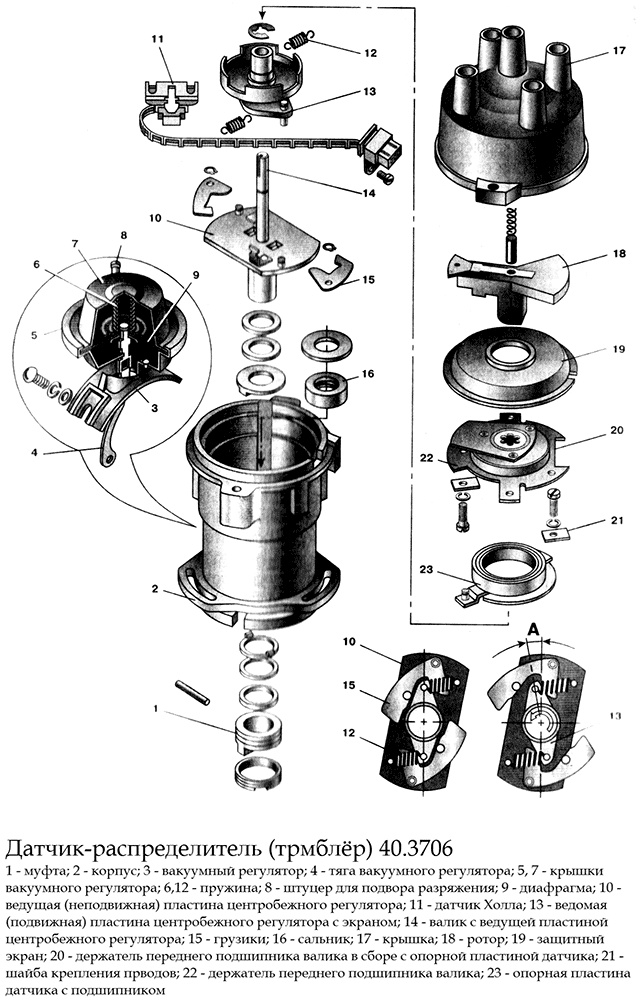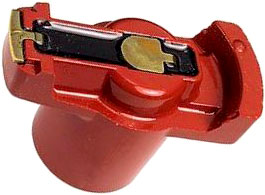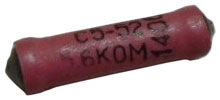
In the ignition distributors (distributors) of many models, rotors (sliders) equipped with anti-interference resistors are used. Read about what a slider with a resistor is, what functions it performs in ignition, how it works and works, as well as the correct choice and replacement of this part in the article.
What is a resistor runner and what role does it play in the ignition distributor
A slider with a resistor is the rotor of the ignition distributor of a contact and contactless ignition system, equipped with an interference-suppressing resistor.
Any ignition system is a powerful source of radio interference that disrupts the reception of radio programs in all bands, both in the car itself and in the vehicle passing nearby. These interferences are heard as clicks and crackles, the repetition rate of which increases with increasing engine speed. Interference is generated by sparks that occur in different parts of the high-voltage circuit of the ignition system: in the spark gaps of the spark plugs and between the contacts in the cover and slider of the distributor. When a spark slips, a wide range of electromagnetic radiation occurs - which is why interference is heard on almost all radio bands. However, the spark itself gives radiation of low intensity, the main power is emitted by components associated with the spark gap - high-voltage wires that act as antennas.
To combat the described phenomenon, additional elements are introduced into the high-voltage circuit of the ignition system - distributed or concentrated resistances. High-voltage wires with non-metallic central conductors act as distributed resistances. Resistors in the spark plugs and in the distributor slider act as concentrated resistances - this detail will be discussed further.
Why does the introduction of a resistor into a high-voltage circuit lead to a decrease in the level of interference? The reason is quite simple. When there is a breakdown of the spark gap, high-frequency currents run through the conductor connected to it, which lead to the emission of radio waves by this conductor. The placement between the spark gap and the conductor of the resistor with a resistance of several thousand ohms changes the picture: together with the capacitances and inductances that conductors always have, a simple filter is formed that cuts off the high-frequency component of the interference. In practice, a complete cut does not occur, however, the amplitude of high-frequency currents in the wire decreases sharply, which leads to a multiple decrease in the level of radio interference in the high-voltage circuit of the ignition system.
If we attribute all of the above to the distributor slider, then the spark gap here is the contacts of the cover and the adjacent contact of the slider, and the high-voltage wires running from the coil to the slider and from the contacts to the candles act as antennas. Thus, here the resistor is between two conductors, but the greatest suppression of interference occurs on the wire from the coil, and the suppression of interference on the candle wires occurs due to the resistance of the wires themselves and the resistors built into the candles.

The ignition distributor and the place of the slider in it
That is why this resistor is called anti-interference (or simply suppressive). However, in addition to combating radio interference, the resistor performs several other functions:
● Preventing (or reducing the intensity) of burnout of the contacts of the distributor cover and the slider itself;
● Reducing the likelihood of electrical breakdown from other high-voltage sources;
● Increasing the service life of candles and related components;
● Increasing the duration of the spark discharge, which in some cases increases the stability of the engine.
Why is all this happening? The reason is the resistance to electric current, which creates a resistor. Due to the resistance in the high-voltage circuit, when the discharge flows, the current strength decreases - it is enough for the spark between the electrodes of the candles to ignite the combustible mixture, but not enough for local melting of the metal of the electrodes and contacts in the distributor. At the same time, the power stored in the coil remains the same, however, due to the increased resistance of the circuit, it is not given to the candles instantly, but for a certain period of time - this leads to an increase in the discharge time, which ensures more reliable ignition of the mixture in the cylinders.
Thus, just one resistor in the slider of the ignition distributor performs several functions that increase the efficiency of the engine and the comfort of the vehicle.
Design and characteristics of the slider with a resistor
The slider (rotor) with a resistor consists of several parts: a cast case, two rigidly fixed contacts (central, resting on the ember in the distributor cover, and a side one) and a cylindrical resistor located in a special recess. The body is made of electrical insulating material, the contacts are usually fixed on it with rivets. Springy plates are made on the contacts, between which a resistor is clamped. In the lower part of the slider body, a figured channel is made for fixing the ignition distributor on the shaft.
According to the method of installing the resistor, there are two types of sliders:
● With replaceable resistor;
● With a non-replaceable resistor - the part is filled in the recess with a special insulating compound based on epoxy resin or vitreous materials.

Slider with resistor
The runners use powerful resistors of a special design with end terminals, designed to be installed between the springy contacts. In domestic cars, resistors with a resistance of 5.6 kOhm are most often used, however, resistors with a resistance of 5 to 12 kOhm can be found in various sliders.
Depending on the type of distributor, the slider can simply be mounted on the distributor shaft (usually such parts are T-shaped), or mounted with two screws on the ignition timing regulator (such parts are made in the form of a flat cylinder). In both cases, the resistor is mounted on the outside of the slider, which opens access to its inspection and, if possible, replacement.
Questions of selection and replacement of a slider with a resistor
The resistor placed in the slider is subjected to significant electrical and mechanical loads, so over time it can fail - burn out or collapse (crack). As a rule, the breakdown of the resistor does not disable the engine, but seriously disrupts its functioning - the engine does not gain full power, responds poorly to the gas pedal, "troit", detonates, etc. The fact is that sparks can slip through a burned-out or split resistor, so the ignition system continues to work, but with violations and less efficiently. When such signs appear, you should first remove the distributor cover (this should be done only when the engine is stopped and with the terminal removed from the battery), dismantle and inspect the slider. If the slider is ordinary, then it can be removed without tools, and if the part is connected to the ignition timing regulator, then two screws should be unscrewed with a screwdriver.
If, when inspecting the resistor, there are no external signs of its malfunction (it is not burned or broken), or the resistor is filled with a compound, then you should check its resistance with a tester - it should lie in the range of 5-6 kOhm (for some cars - up to 12 kOhm, but not lower than 5 kOhm). If the resistance tends to infinity, then the resistor is faulty and should be replaced. A part of the same type and resistance should be taken for replacement - this is the only way to guarantee that the resistor will fall into place and the whole system will work normally. Replacing the resistor comes down to simply removing the old part (it is convenient to pry it off with a screwdriver) and installing a new one. If the resistor is filled with a compound, then you will have to change the entire slider - for domestic cars, such a replacement will cost several tens of rubles.

Slider with a compound-filled

Resistor Replaceable resistor for the slider
Often, car owners install wire jumpers instead of resistors - it is strictly forbidden to do this. The absence of a resistor increases the level of radio interference and can disrupt the operation of the ignition system (including leading to intensive wear of the contacts of the slider and distributor cover, and the electrodes of the spark plugs). It is also not recommended to change the slider with a resistor to a simple slider in ignition systems with high-voltage wires of zero resistance. Only those types and models of sliders recommended by the manufacturer of the ignition distributor should be used for replacement.
With the right choice and replacement of the slider with a resistor (or only a resistor), the ignition system will work reliably and with minimal "pollution" of the radio air.
Post time: Jul-12-2023
